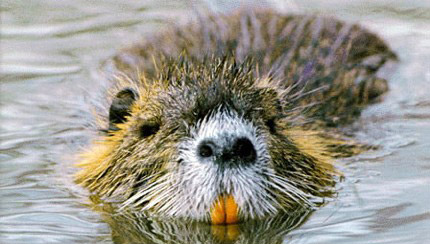Nutria (Myocastor coypus) are beaver-like rodents native to Argentina that have recently been identified in several western Washington lakes, including Lake Washington. Across the United States, their voracious eating habits (they can consume up to 25% of their body weight in food each day) have meant billions of dollars in damage to native wildlife habitats and agricultural lands.
 Although accounts of their introduction to the United States vary, several sources agree that nutria were first raised on California farms in the late 1800s for their pelts. The nutria population spread to other states in the 1930s and 1940s as entrepreneurs marketed the animals to control nuisance aquatic weeds. As a result, nutria can now be found in Oregon and some parts of eastern Washington, including the Yakima basin and spots along the Columbia River, in addition to locations in western Washington.
Although accounts of their introduction to the United States vary, several sources agree that nutria were first raised on California farms in the late 1800s for their pelts. The nutria population spread to other states in the 1930s and 1940s as entrepreneurs marketed the animals to control nuisance aquatic weeds. As a result, nutria can now be found in Oregon and some parts of eastern Washington, including the Yakima basin and spots along the Columbia River, in addition to locations in western Washington.
Although nutria are strict herbivores and may control nuisance or noxious plants in or around a waterbody, they do not seem to prefer one plant species over others. Thus they can out-compete native wildlife for food and decimate beneficial native plants.
Nutria have become a huge problem in the marshlands of southern Louisiana, where they were released in the 1930s or 1940s to control water hyacinth. By the 1950s, reports of rapid population growth and damage to marshes, agricultural fields, and natural levees led to the removal of nutria from the list of protected wildlife. From 1962-1982, the fur trade kept nutria in check. However, as the fur trade declined in the late 1980s, nutria populations increased and so did damage to natural and agricultural areas. Today there are known nutria populations in at least 15 states.
At a glance, nutria look similar to beavers or muskrats. However, they are generally smaller than beavers and larger than muskrats – adults average between 11 and 22 pounds. The most obvious distinguishing trait of nutria is their tails. Unlike beavers’ wide flat tails, nutria tails are thin, round, hairy, and pointed at the tip. A muskrat’s tail is hairless and flattened vertically.
Nutria breed rapidly and can quickly become a problem in a new area. Females can begin breeding at six months old and usually produce one to three litters a year. Commonly, litters number two to five young, but can be as large as twelve. Nutria young can swim within 24 hours of their birth and begin to feed themselves within a week. Adult nutria may be preyed on by coyotes, dogs and humans, while the young are also vulnerable to foxes, birds of prey, herons and raccoons. The average lifespan of nutria in the wild is about three years.
Nutria live in the banks of backwaters, sloughs and wetlands, as well as irrigation and drainage ditches. They burrow large dens into banks, which can create problems with erosion and structural integrity. They do not build dams, but may use abandoned beaver lodges or muskrat feeding platforms. They make slides about six inches wide – between muskrat and beaver slides in size. Nutria are well adapted to traveling long distances over land, making it easy for them to find new places to live as their numbers grow. Their numbers may be limited by cold winters when ice forms on open water for long periods.
Nutria, along with beavers, muskrats, rabbits and voles, can be infected with the bacterial disease tularemia, which can be spread to humans through biting insects or direct contact with infected animals. Because they regularly defecate in water, nutria droppings can also spread a flu-like infection sometimes called “beaver fever.”
Nutria are considered an unclassified species for animal control, which means that they may be trapped or killed year round without a special permit. However, it is unlawful to release nutria anywhere in Washington aside from the property where they were taken, unless a special relocation permit is obtained. If you spot what you think is nutria at your lake, call the Washington Department of Fish and Wildlife to discuss next steps.
To learn more, visit these websites:
The U. S. Department of Agriculture’s Animal and Plant Health Inspection Service:
www.aphis.usda.gov/lpa/pubs/fsheet_faq_notice/fs_wsnutria.html
Washington Department of Fish and Wildlife:
wdfw.wa.gov/living/nutria.html
Woodland Fish and Wildlife Publication MISCO 196:
www.woodlandfishandwildlife.org/pubs/beaver.pdf
More about Nutria
www.nutria.com/site.php


